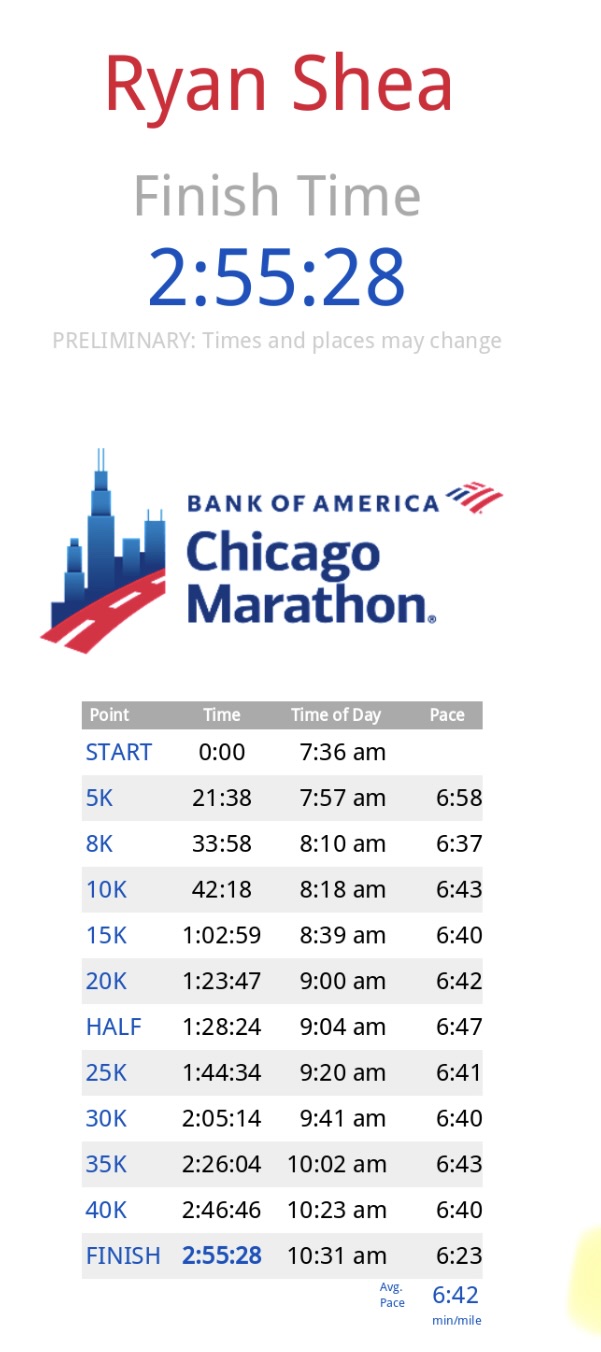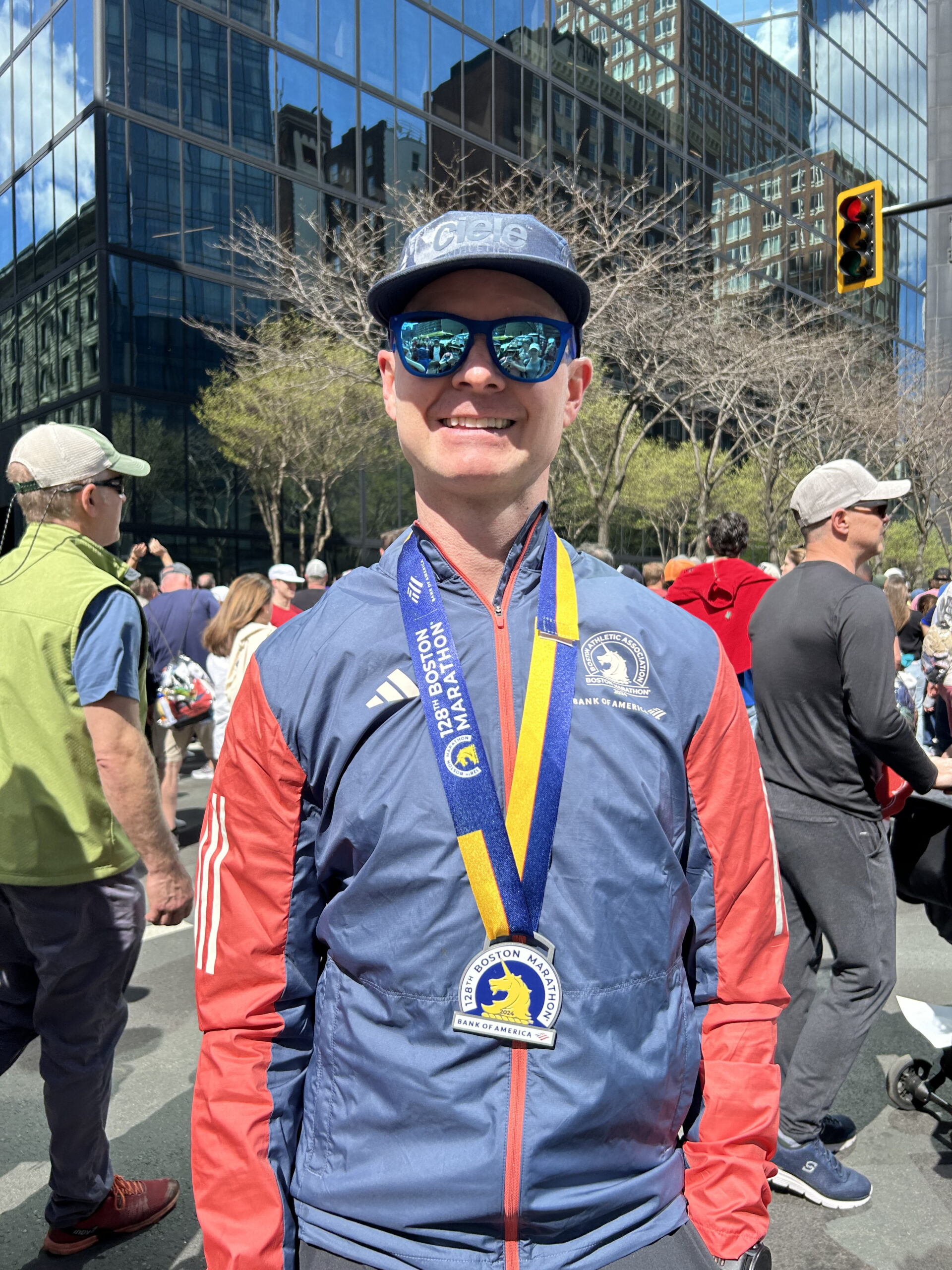
Coming off a “bucket list” event such as the Boston Marathon, can leave one with a feeling of let-down unless you have something else scheduled. Fortunately for me, I didn’t have a lot of time to experience a let-down as I was already scheduled to participate in what would be my second Half Ironman (in which I would only be completing the run). Once my body had sufficiently (or insufficiently) recovered from the Boston Marathon, it was time to start training for what has proven to be quite a tough ½ marathon in the hills of Huntsville.
I took 4 full days off from running (I had planned to take more time off, but decided that I wasn’t leaving Boston without one more run) before I set out to start training again. I had only twelve weeks to recover from the gruelling course, the Boston Marathon and be ready for Muskoka. As is my typical pattern, the first several runs hurt. The best way that I can describe my pain post-marathon is that once I start running again, it feels like someone is sticking knives into my quadricep muscles with every step. This feeling tends to ease off by about the 3rd or 4th run.
After about a week of just easy running, my legs started to return to some semblance of normal so I began testing them. I added some speed work into my routine one day a week, which started in week two. In addition, I decided to dedicate some more time to strength training during this training cycle. I sought out the expertise of local kinesiologists Steve and Hanna Coons at Thrive Fitness in Alliston. Finding appropriate windows to add some intensive strength training into my routine when running 6 days per week wasn’t easy, but I decided that I could work out at Thrive on Mondays and work out independently at my newly furnished clinic gym on Fridays. Research indicates that strength training twice weekly with high weight/low repetitions is ideal for injury prevention and potentially will help performance.
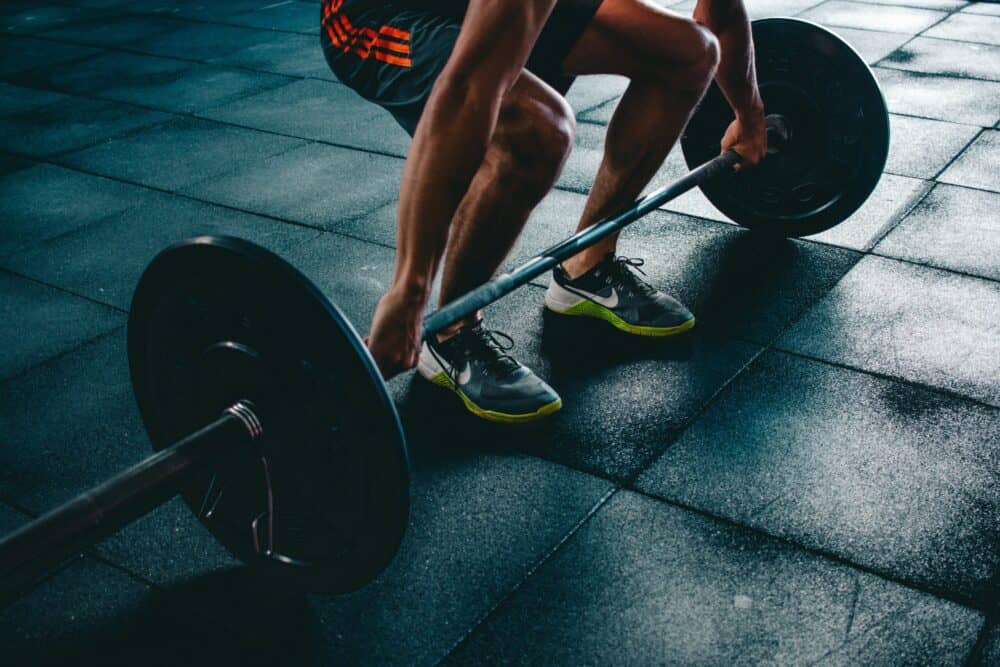
Training (both strength and running) went smoothly leading up to the Muskoka Ironman. I was mildly concerned about developing an injury with the addition of the strength element but did not encounter any issues. After the reverse taper (building my mileage back up after the marathon) I was back to running about 100km per week prior to the event. The draw of this event is the team atmosphere that the relay creates.
Stephanie was once again our swimmer and Glenn was the cyclist. Stephanie had a strong swim given that her training suffered leading up to the Ironman and Glenn was cruising along on the bike until he was blindsided by another cyclist near the finish costing him 10mins. When it was time for me to run, it was once again approaching 11 am and getting hot. That said, I felt strong in the hills and was able to run controlled throughout the entire event. I once again felt a bit embarrassed passing large amounts of the runners knowing that they had already completed grueling swims and bike rides. That didn’t stop me from pushing hard (though at the advice of my coach not quite 100% as this was not my “A race”). With about 1 km remaining I decided that it was time to try to empty the tank, so I turned on the jets and raced to a time almost identical to last years’ time.
We finished 10th out of 27 relay teams and I had finished as the second fastest runner in the relay category. In looking at the time that we had lost in the bike mishap, we likely would’ve finished top 5 if it had not been for the carelessness of the other cyclist.

Upon completion of the Muskoka Ironman, I had to get right into marathon training for the Chicago Marathon as it was only 14 weeks away. Although 14 weeks sounds like a long time, I generally allow for 16-20 weeks of training for a marathon (assuming that I’m already in good shape). Fortunately, my legs weren’t feeling too beat up after the run, so I was able to jump right back into training while we were away at a cottage. For some of these runs, I even had a training partner as my oldest daughter Tia had decided that she wanted to run the 10km Army Run in Ottawa with me in September. The hills, the heat, and the bugs up in cottage country always make running a bit more of a challenge, but I enjoy the variety. Unfortunately, Tia’s knee became a problem after some of these runs, so we had to scale her program back and nearly start it over again.
Through the rest of July and into August training continued. I was running my usual 6 days per week and anywhere from 110-130 km on any given week (often twice daily to keep Tia company on her runs). I was feeling quite strong until the first week of August I was bitten by the dreaded “injury bug”. Leading up to the injury I had been working out at the gym and we had targeted hamstrings for a key workout. For a couple of days afterwards, I had some increased tightness in the hamstrings. Then, on a run with some speedwork, I felt a huge cramp in my hamstring that stopped me instantly. Being a few km’s from home I walked part of it, then very gingerly jogged the remainder. I feared that this might be the end, or at least a very significant interruption in my training cycle. For the first time in forever, I had to take a few days off running. Thanks to some great associates at South Simcoe Physiotherapy (Jayke and Fatemeh), some massage work from Kyle at Bodies in Balance, and some self-guided work I was able to run again after a couple of days (with some pain and limitations).
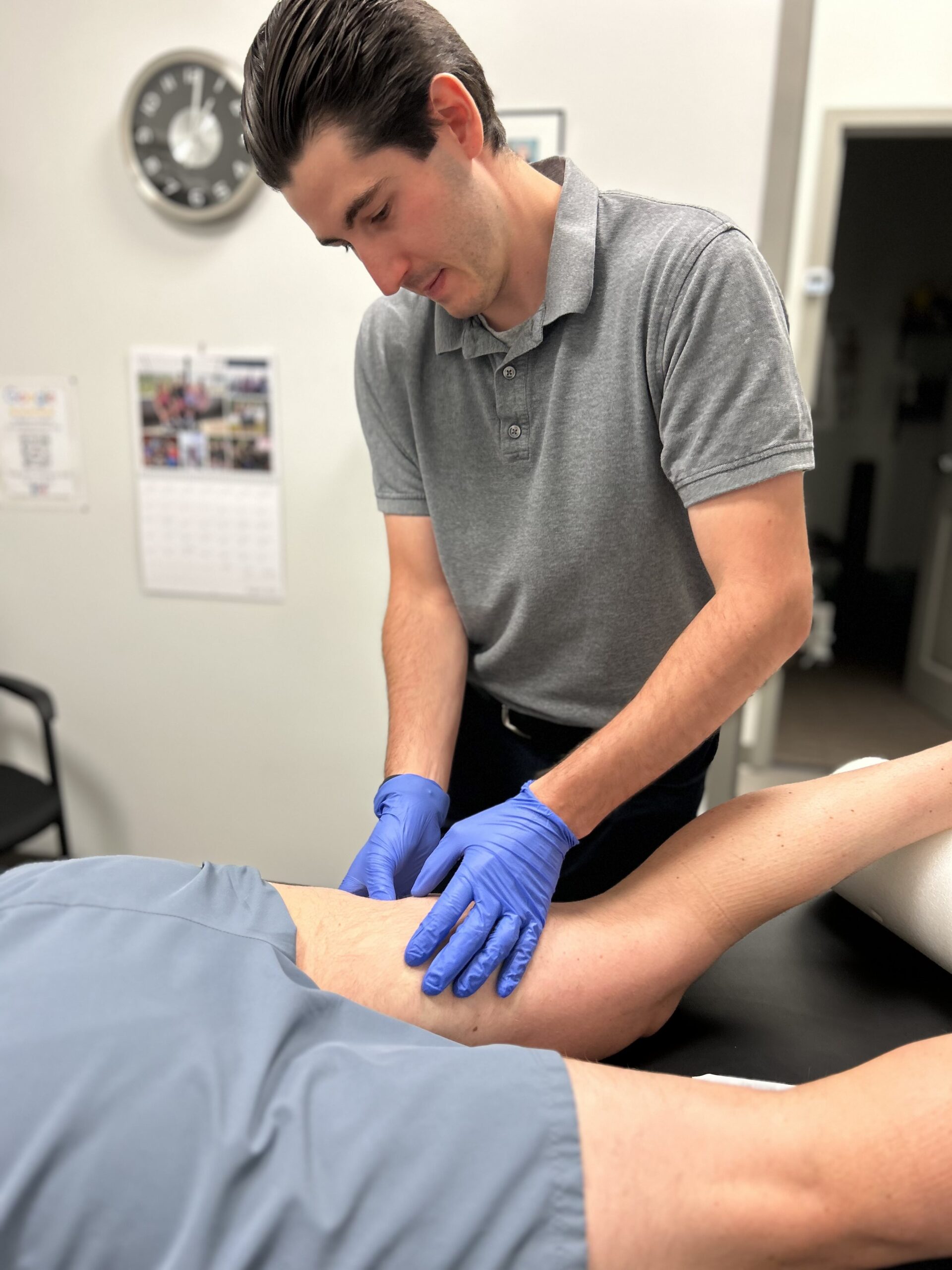
Just when it seemed that the hamstring injury was behind me, I had a visit from an old friend; the Achilles tendinopathy that bothered me for six months prior to the Boston Marathon was back. There wasn’t an acute injury to my Achilles; I just started to notice more and more tightness, especially upon awakening in the morning. So, my attention shifted from dealing with the hamstring injury to dealing with the Achilles tendinopathy.
A very important part of marathon training is marathon recovery. I do my best not to neglect nutrition and I work on mobility, use my normatec compression boots, sit in the hot tub, and use a massage gun nearly every night before bed. The one area that I probably lack in is the sleep department. I do try to get to bed early as I am up at 5 am each day to get my runs in. Like many, I go through periods where sleep just doesn’t come easily and certainly almost never get 8 hours of sleep (and in many cases, experts will recommend more like 9+ hours when you are training daily). Perhaps it was the lack of sleep that caught up to me and led to both of these injuries. Luckily for me, this injury too was short-lived and I didn’t have to modify my training for it at all.
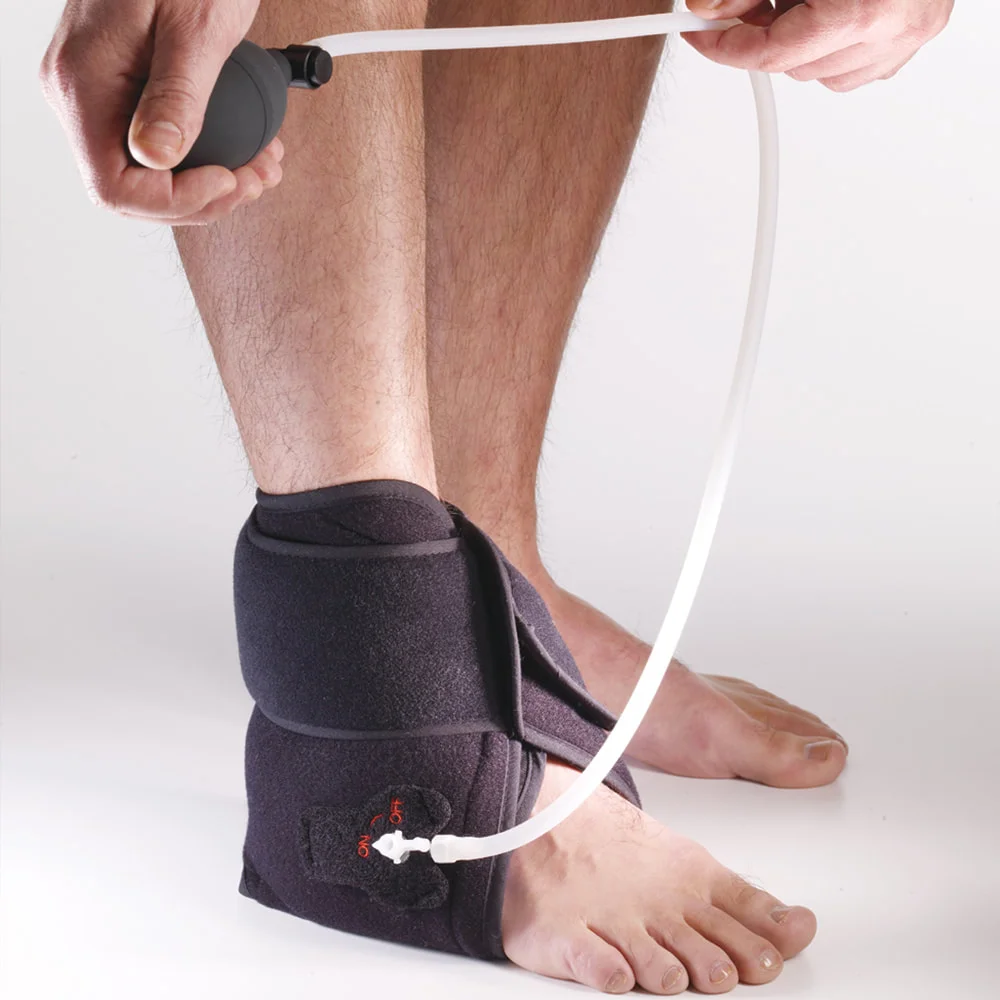
Back in July, my good friend and partner in the Real Running Course connected me with the good people at Black Toe Running to hook me up with some new shoes. I was like a kid in a candy store and left there with a couple of pairs of shoes and some new running attire. Included in my haul was a pair of the newest Nike Alpha Flys which were very different from the Saucony Endorphin Pros that I have run all of my previous marathons in. I was really excited to try these shoes out, but like that Christmas present that you know you have to wait for, I put them away until it was time to break them in for Chicago.
The first opportunity that I took to start breaking in my new shoes was the 10km Army Run in Ottawa that Tia and I had signed for. We made the drive up to Ottawa on the Friday after she was done school, arriving late on Friday night. Saturday, we spent the day at the expo where our goal was to find a nice hoodie for Tia and to explore some of the army equipment that they had on display. We of course shopped at the Rideau Centre and anyone who knows me will know that I had scoped out some restaurants for us to dine at. Sunday morning, we were early to rise, get some nutrition into us, and then head down to the start line. My parents surprised Tia and made the drive to Ottawa to support Tia on her run. I paced Tia for the run and she easily surpassed her goal of under 1hr with a finish time of 56:26. I couldn’t have been happier for her!
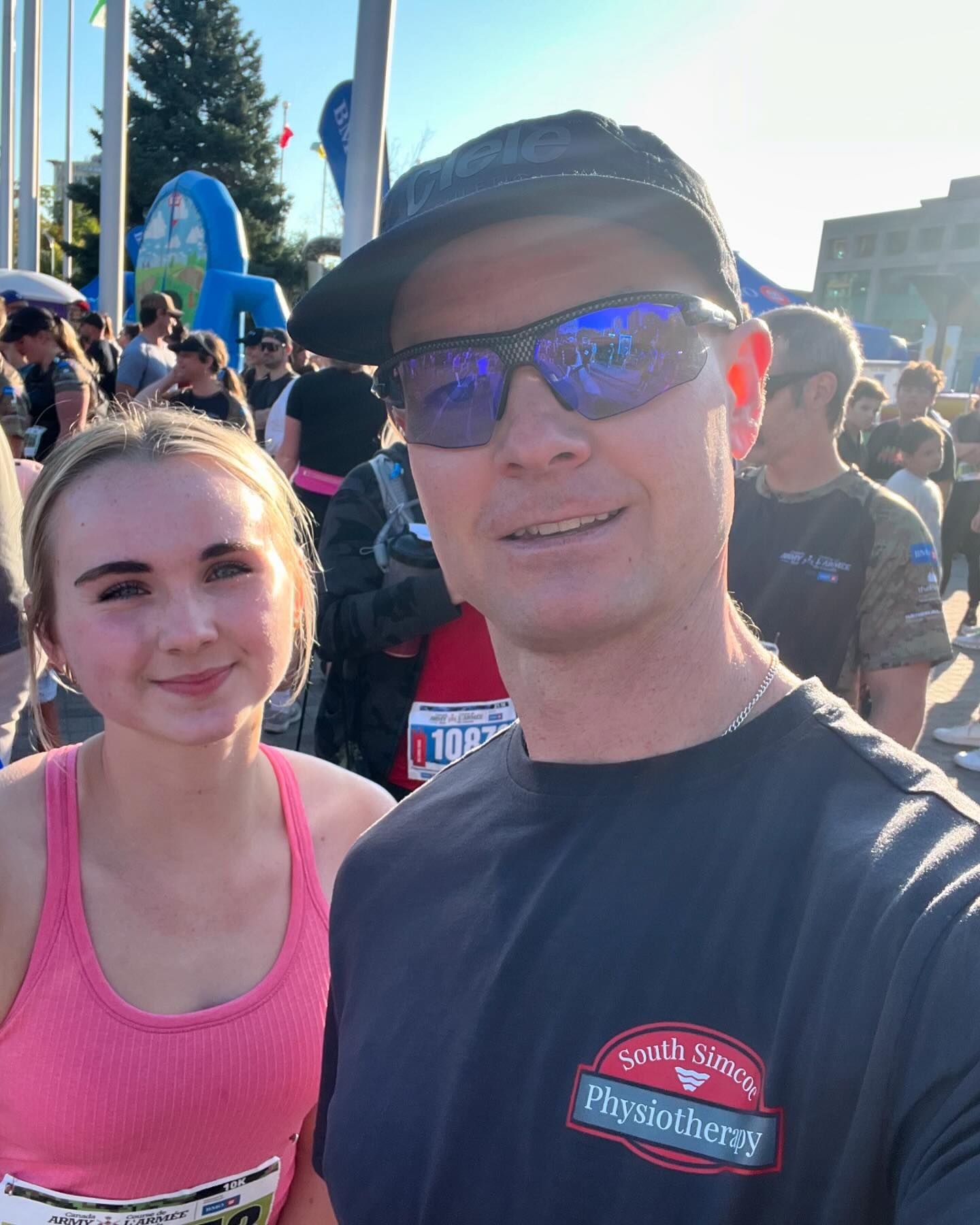
The shoes felt fine during the 10k race, though they were certainly different than any shoe I’d ever worn. After wearing them for a bit of a longer run on the Saturday 2 weeks before Chicago, I noticed a crack in the midsole of the toe of the shoe. This was completely unexpected after only about 30km of wear. I contacted Nike right away and they suggested that I contact Black Toe Running. So, on a Saturday afternoon, I called Black Toe Running and the gentleman I spoke to gave me an email address to send all of the info to. I did that and got an immediate response with the info that they required. After a couple of back-and-forth emails, I was told to bring the shoes back and though they wouldn’t be able to get me the same shoes (I wasn’t sure I wanted them anyway, to be honest) they would make sure that they got me into something just as good. First thing Sunday morning (after my run of course), my running friend Mike and I made an impromptu visit to Black Toe Running where I was once again greeted with exemplary service. They exchanged my shoes with no questions and even gave me a deal for the trouble this had caused. I ended up leaving with a pair of Nike Vaporfly 3’s (and of course another pair of shoes and some attire).
With only a couple of weeks until the big day, I now had a brand-new pair of shoes that I had to break in and though I had some time, I typically like to get at least one long run in my shoes before the marathon and entering my taper I didn’t have any runs left that were over 16km. Immediately, I felt like the Vaporflys were better suited for me than the Alphaflys, so I was confident that they would be fine on gameday.
Like many runners, I have mixed feelings about the taper. Running has become such a part of my life (and my coping strategy) that when I’m reducing my mileage (in this case I peaked at 140km/week and in my last week before the race I only ran 40km) it can be tough. That said, I have come to realize the importance of it so I do “obey the taper” and try to use the extra time to get a few extra minutes of sleep.
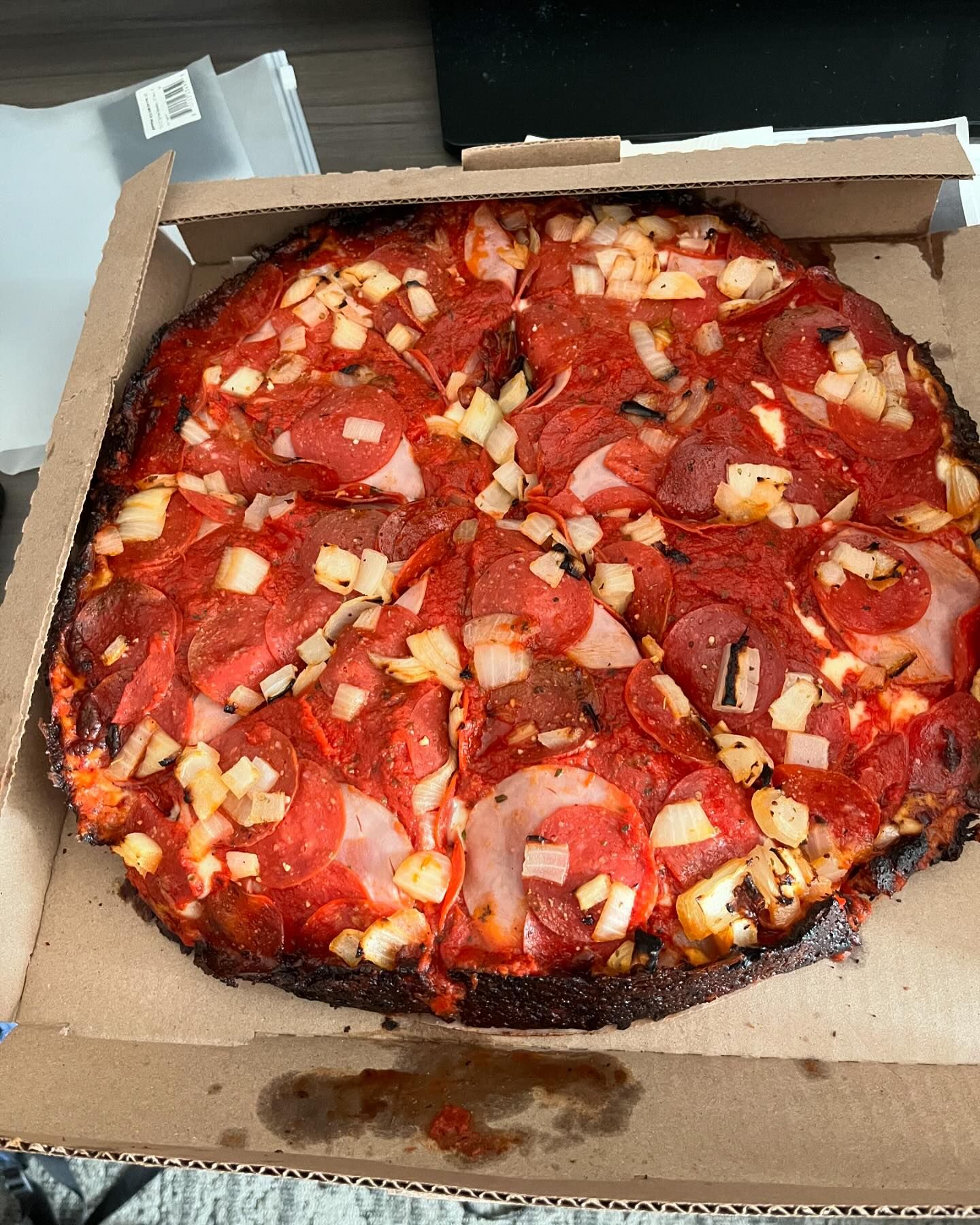
We left for Chicago on the Thursday before the race. Accompanying me on the race this time were my mom and dad. Three days before each marathon I embark on my “carb load” which allows me (in fact encourages me) to eat some foods that I often try to avoid. With the car and snacks packed, we left for our 10-hour car ride to Chicago.
Prior to race day, my parents and I toured the city sampling some great restaurants and taking in some sight-seeing. We had some great deep-dish pizza, took in a “gangster tour”, the architectural boat tour, and post-marathon we were able to tour Wrigley Field. I was likely on my feet a bit more than I would have liked to have been prior to a race, but it is always a delicate balance between enjoying the experience and being race-ready.
On race day, I awoke at 430 and began my preparation. Electrolytes, a plain bagel with peanut butter and honey, and a banana have become my breakfast of choice pre-marathon due to the ideal mix of easily digestible carbohydrates, some fats and protein, and the fact that it travels well. I had decided to walk the 30 minutes to the start line to avoid the stress of trying to figure out public transit, so I set off on my walk seeing many others walking from their hotels as well. I arrived at Grant Park just prior to 6 am with a scheduled start time of 7:30. Since I don’t run with my phone, I was left alone to my thoughts sitting and waiting for the race to begin. I will say that the atmosphere and anticipation were not quite the same as in Boston, though there were twice as many runners in Chicago. At 6:40 I decided that I had better get in line for the porta potty and it’s a good thing I did as I didn’t get out of the line until about 7:15!
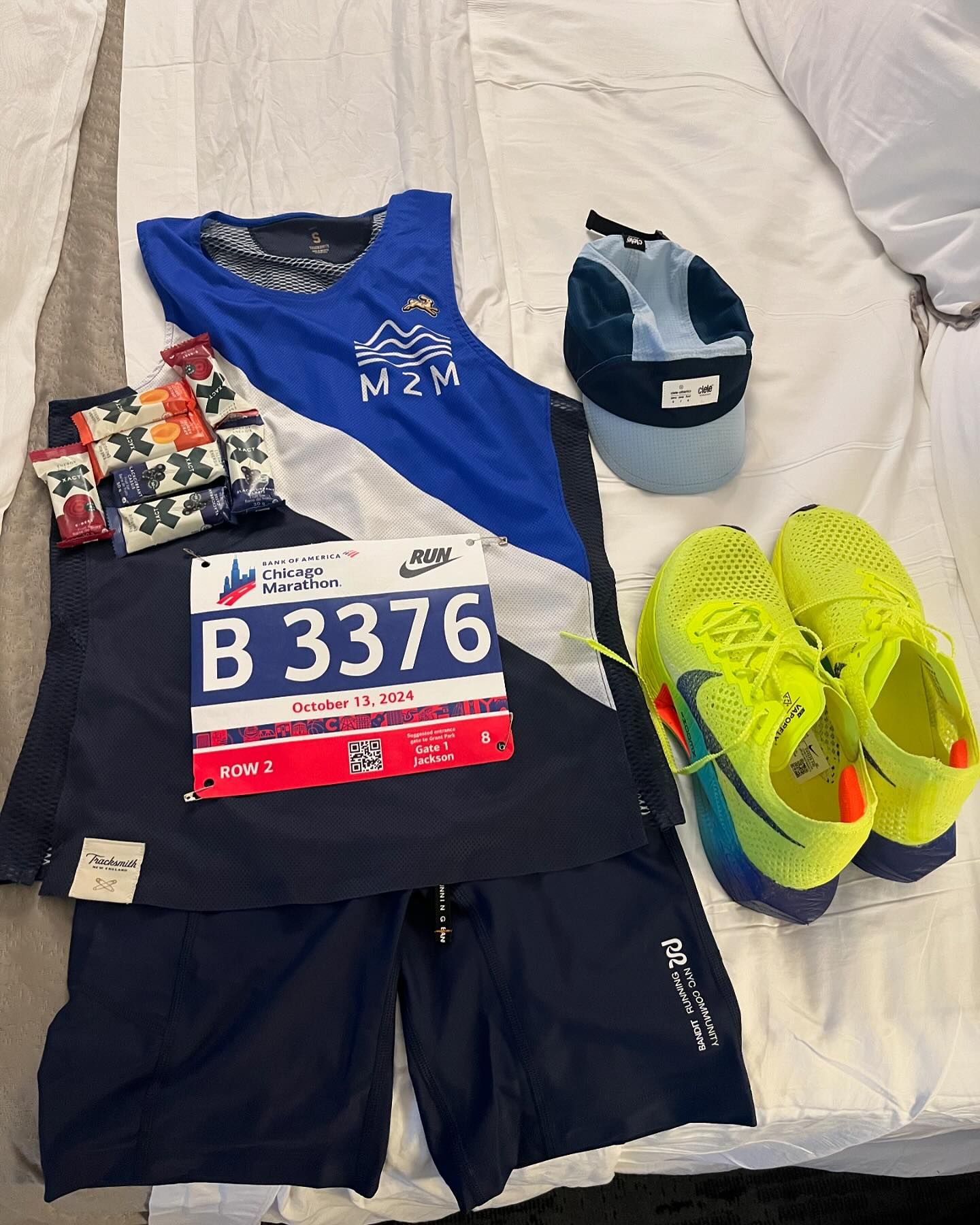
I didn’t feel as though I needed a big warm-up after having a 30-minute walk to the start line and it’s a good thing as there really wasn’t much space to warm up anyway. I saw groups of people jogging around the porta potties (which I really wasn’t planning on doing), so I just did a very basic warm-up with a few drills that lasted less than 10 minutes. From there it was time to get into my starting coral (which puts you in a large group of people that should be of similar speed). This meant that it was time to strip off the $8 hoodie that I had bought from Value Village, while I kept the dollar store gloves on for the first part of the race.
Once in the coral, we had a moment of silence for Kelvin Kiptum the Kenyan runner who set the marathon world record in Chicago just last year and then was tragically killed in a car accident a few months later. First, the wheelchair athletes start, next the elite runners, then coral A, then coral B (which was the coral I was in) and so on. Just prior to starting someone stepped on a water bottle next to me which sprayed my shoe and sock. Next, a runner beside me tapped me on the shoulder and said “Sir, you have some toilet paper stuck to your shoe” (“am I old enough to be called sir”, I thought?); what a start!
Once the gun went, it was much like every race I’ve done. My focus becomes very internal for the vast majority and I am aware of very little of what’s going on around me. I was intentionally slow going out because it is very easy to get caught up in the hype and burn your matches too quickly, as my coach Garrett would say. Much like Toronto, the combination of tall buildings and perhaps 50,000+ people using GPS on their watch made my GPS watch useless throughout much of the start. The problem with this is that we rely on the watch to give us feedback on our pace. Without GPS you are relegated to running by feel and basing it on effort. In Boston, I ran based on effort, but this was due to the fact that the conditions were warmer than anticipated so I knew that I wouldn’t be able to keep my goal pace. In Chicago, the conditions were perfect, 12-13 degrees Celsius to start and reaching 18 by race end, but the lack of GPS signal for the beginning part meant that I once again had to run based on effort.
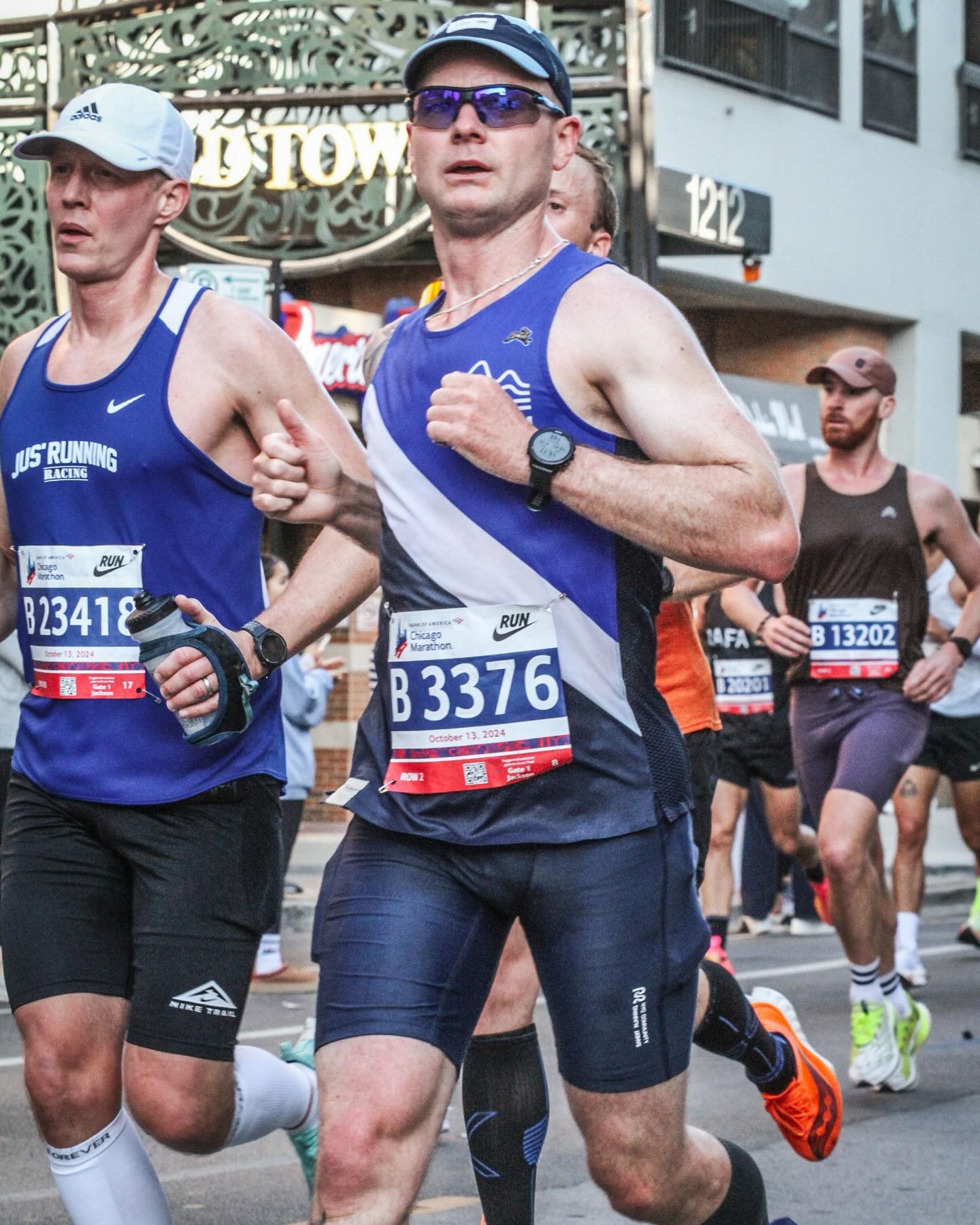
In looking back on the race, those first few km were perhaps a tad bit slower than I would’ve likely run them if my GPS had been working, but better too slow than too fast. From there, my focus became being on the left side of the road in order to see my parents. Their plan was to be at approximately the 3-mile and 12-mile marks and to be on that side of the road. At around 6 km I had resigned myself to the fact that I must have missed them (you’d be surprised how lonely of a feeling that gives you) when I finally saw my mom’s phone in hand and my dad throwing up his hand to wave. This few-second interaction was all I needed to refocus.
The crowds in Chicago were great though certainly not nearly as loud as the Wellesley College or Boston College crowds and can I say a little less “professional”. I saw several people trying to get from one side of the road to the other and often cutting off runners to do so. I had one young woman (pushing an empty wheelchair) run right in front of me forcing me to break stride (and yell an expletive!) in order to dodge her. I didn’t see any of this in Boston, though I can’t say that it didn’t happen.
Another potential hazard that I was unprepared for was the bridges in Chicago. The first bridge that I encountered, I happened to be on the right side of the bridge on approach and noticed that there was a red carpet on it much like a “runway”. You could tell that the bridge was not solid concrete but instead had a metal grate underneath the carpet, but it was fine to run on. The next bridge I encountered I was not on the red-carpet side, so I ended up running on the metal grate. The grate ended up being very unstable to run on (I have since heard several reports of people falling on these bridges). From there when I encountered a bridge, I made sure to get over to the right side where the red carpet was.
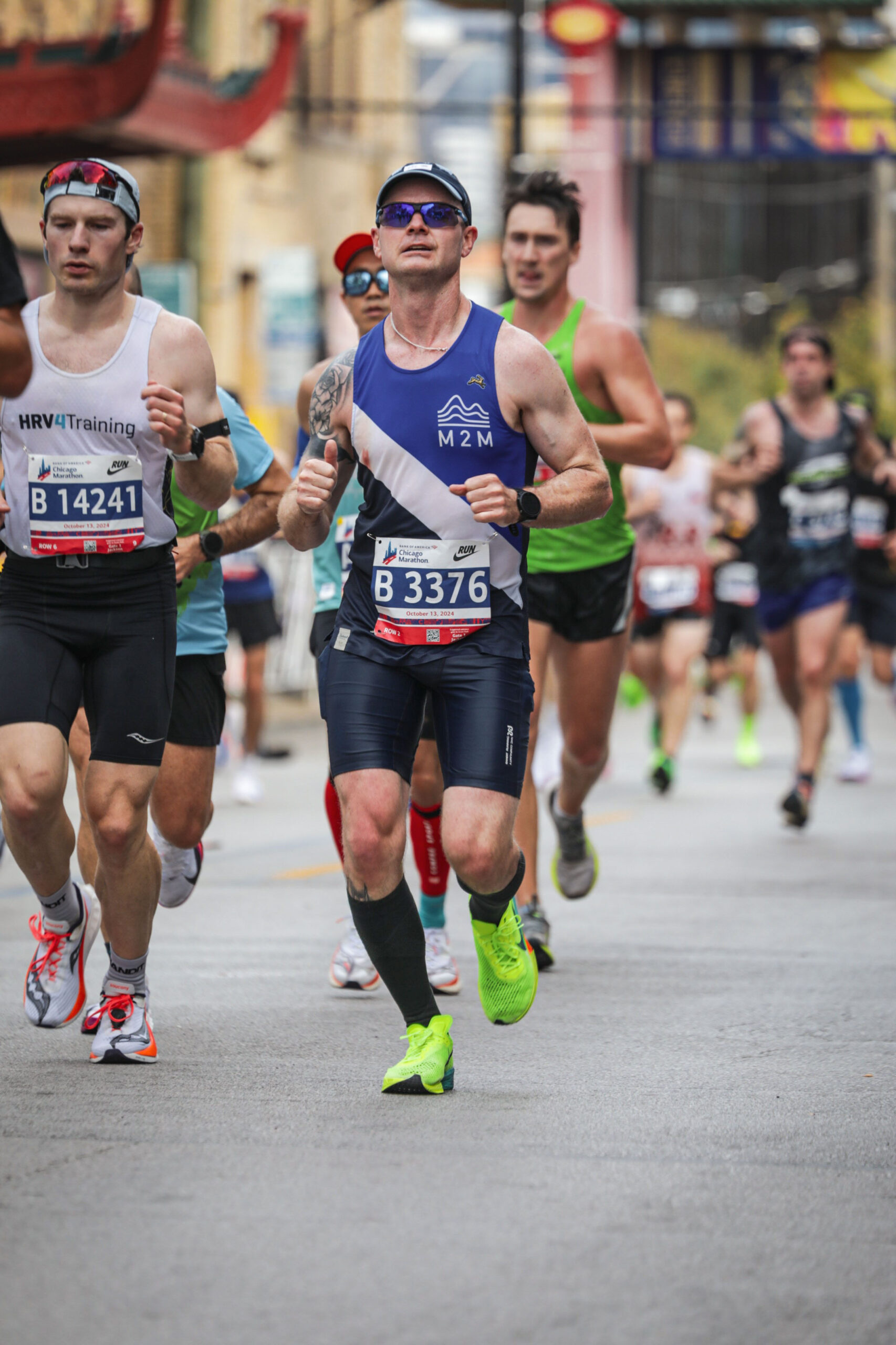
At mile 12 I once again saw my parents, this time both of them with phones in hand to get a picture. With the ideal weather temps and a good training cycle, I was still feeling strong at the halfway point. I passed the halfway marker at 1:28:24 which puts me on pace for approximately a 2:57 finish. Having those couple of injuries leading up to the marathon, I did not think that I would beat my personal best of 2:55:06 but hoped to be close.
At the 35 km mark, I was still feeling strong. This is often the point in the race where I start to question my sanity and life decisions, but not so in this race! I was running beside someone at this point, and though I am not typically one to talk much during the race, he and I shared a few words. He told me that his goal was 2:50 and I told him that mine was 2:55. I knew that he would have to pick it up a lot in order to make that time, so I wished him luck and told him that I wasn’t going to chase him.
Despite being in the zone during the race I do remember the areas of Old Town and Chinatown. Chinatown had a large arch and a very distinguishable building when we entered (please don’t ask me to describe it!). Getting towards the end of the race, there was a short “out and back” to finish it off. Like a sort of mirage, nearly the entire race my watch was telling me that I was 500 meters+ further along than I was. I believe it was a combination of my GPS not functioning and the wide roads, cutting over to get on the carpet for the bridges, trying to be on the left side of the road to see my parents, and weaving around slower runners. Nonetheless, in the last 2 km, I felt like I had more fuel in the tank than I had ever had. Again, I attribute this to the training cycle as well as training my stomach to be able to tolerate more “gels” and Gatorade during the run (I consumed one gel every 30 mins throughout the race and at every aid station I took a Gatorade and water whereas normally I alternate). In the last 2km, I was able to get my pace to about 3:50/km and had a bit of a sprint left in me for the final. I even passed my new friend who was aiming for the 2:50 finish time and encouraged him to run with me, but evidently he was gassed.
I crossed the finish line with a finish time of 2:55:28 and to be honest, I wasn’t sure if that was my new personal best or not. I was certainly happy with my effort as I really felt as though I left it all out on the course once again, but being 22 seconds shy of beating my personal best was slightly disappointing. When I dissected the run, it appeared that I ran an extra 500 m compared to my typical marathon (due to all of the bobbing and weaving) so although I ran a better race, I finished with a slower time. Though not quite satisfied, I have told myself that I have to enjoy the process and be proud of the accomplishment nonetheless. I realize that I won’t be able to beat my PB every time I race, so what I need to do is give an all-out effort and be satisfied with the result. I escaped another marathon without major injury, all that I was left with was a sore left hip (nothing new there), a blistered second toe, and a bloody nipple (the worst of the three for the first couple of days!).
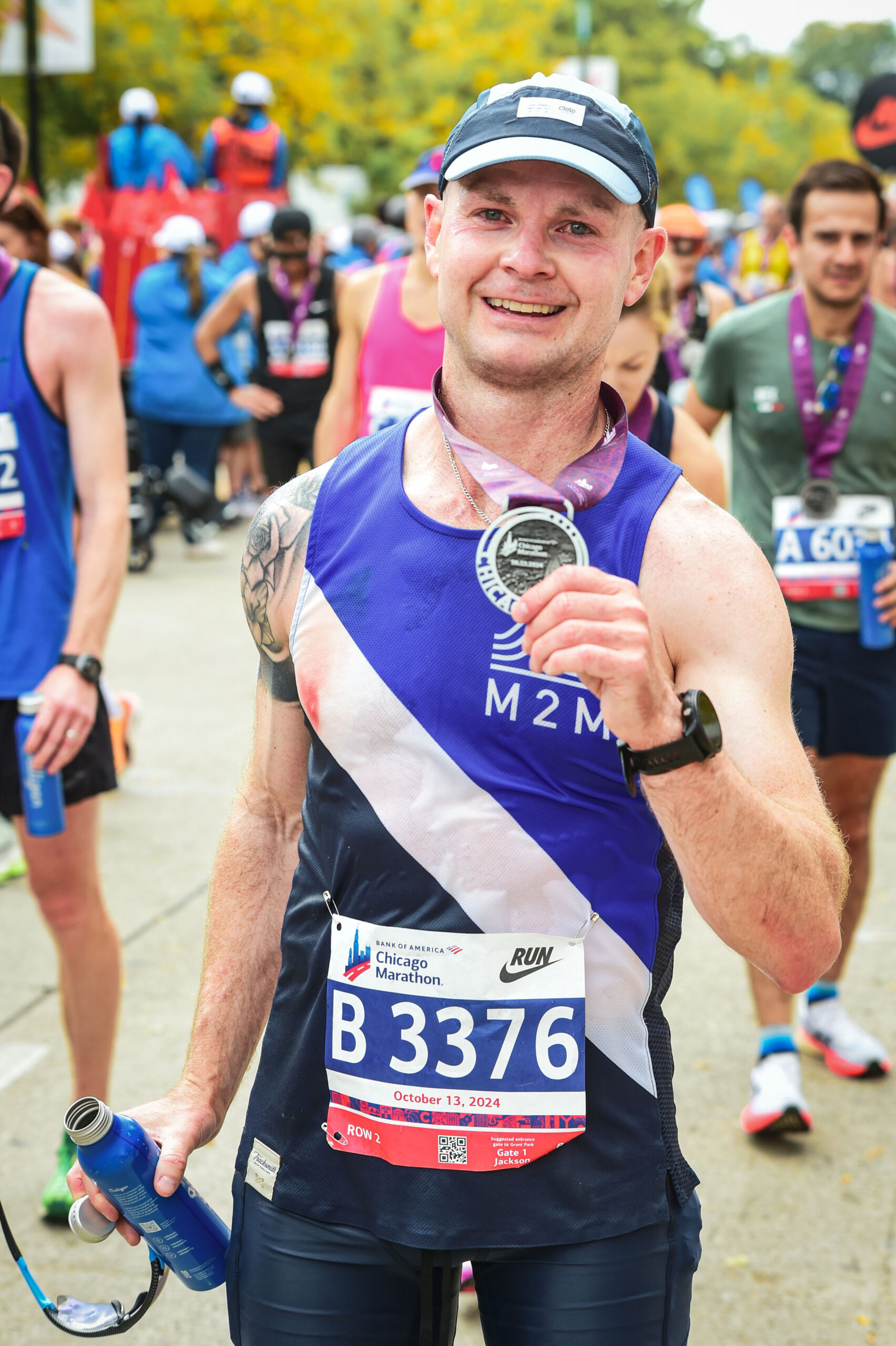
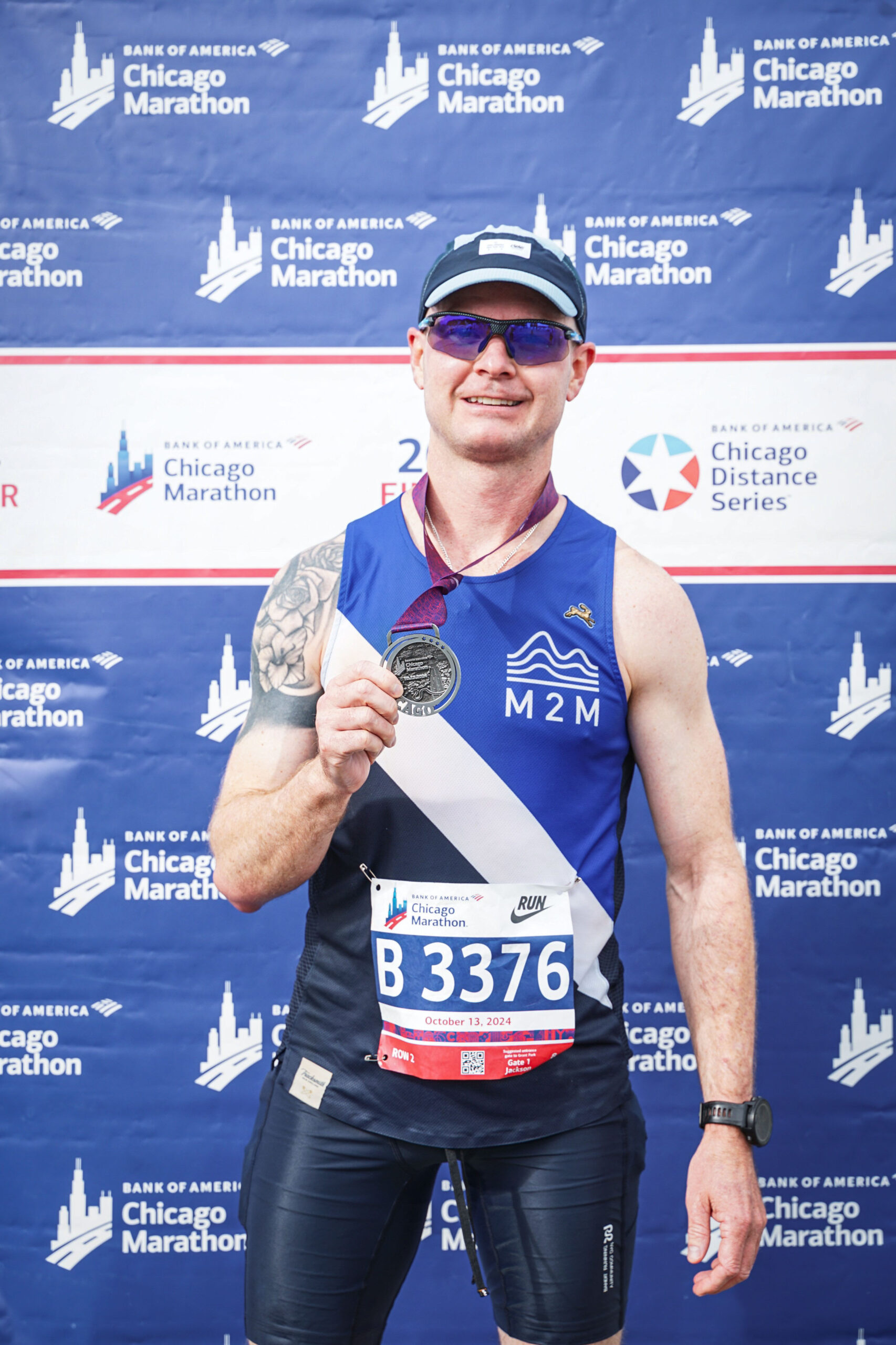
My parents and I did a bit more sightseeing before leaving for home on Tuesday. It was a riot having my parents there for the weekend, as we hadn’t travelled with just the 3 of us since I was in high school. Recovery from this marathon went much better than any of the previous 4 I had run. Normally, going downstairs or getting up off a chair is quite an adventure for 3-4 days post-marathon, but this time I could do those things with very little effort at all.
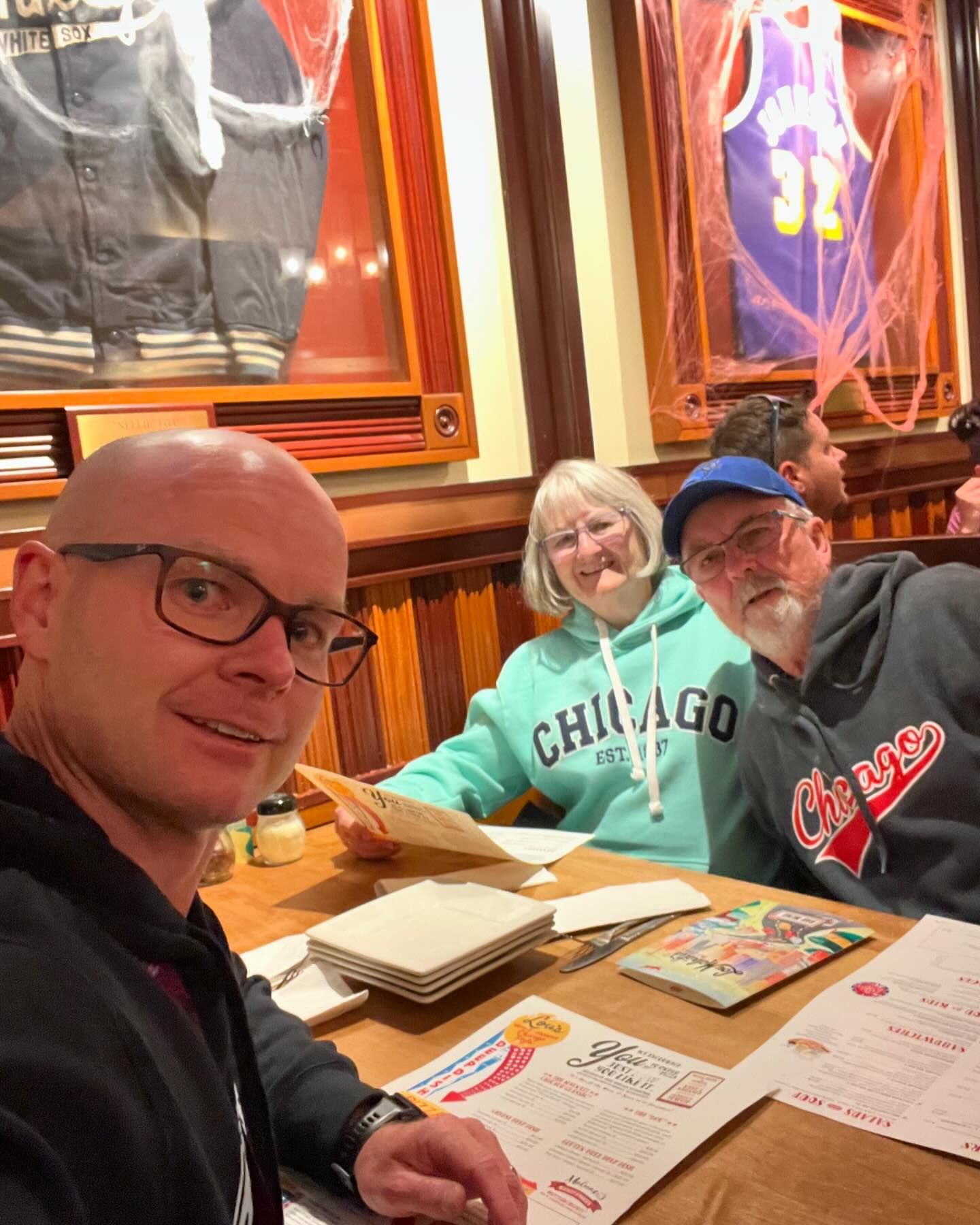
Upon returning from Chicago, I decided to make a couple of changes to my plan for the upcoming season. First, I would look for a new coach. Garrett, my coach for the past 2 seasons and the only coach that I’ve ever had for running, has been fantastic. I certainly owe a lot to him over the past 2 years for his training plans, as well as his support and advice. That said, I am curious to see what other training philosophies there are out there, so I got in touch with Kevin from mile2marathon and have decided to move forward with him as my coach for the upcoming season. Next, I have begun to reconsider my race schedule for next year which included running New York City next November. There are many reasons that I am considering not running NYC next year, but the main reason is that it is not a course that is conducive to running your fastest (much like Boston). Though I am trying not to focus on the time, at the end of the race that is what you’re left with. Given that I will be 44 next spring, (that’s even hard to say), I don’t have many years left of lowering my times in all likelihood. In speaking with my new coach, I believe that I might postpone my running of NYC and some of the other majors, instead focusing on a few small marathons that I can put up a good time on. I will also likely do a few more non-marathon races throughout the season, acting as time trials and preparing me for a fall marathon.
As I sit here reflecting on the last several years of running and preparing for what is to come, I want to once again say thank you to all of my friends, family, patients, and everyone else who continues to support me! I still smile every time I cross one of the mats that scan my chip as I’m running as I know that it’s registering my time for all of those that are following along. Stay tuned, I can’t wait for what’s next!
